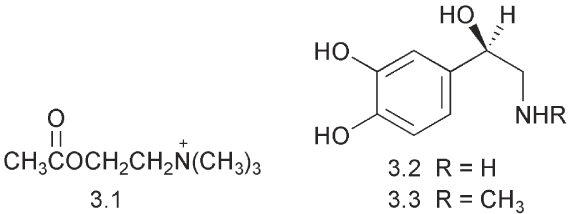


 علم الكيمياء
علم الكيمياء 
 الكيمياء التحليلية
الكيمياء التحليلية 
 الكيمياء الحياتية
الكيمياء الحياتية 
 الكيمياء العضوية
الكيمياء العضوية 
 الكيمياء الفيزيائية
الكيمياء الفيزيائية
 الكيمياء اللاعضوية
الكيمياء اللاعضوية 
 مواضيع اخرى في الكيمياء
مواضيع اخرى في الكيمياء
 الكيمياء الصناعية
الكيمياء الصناعية |
Read More
Date: 18-1-2016
Date: 18-1-2016
Date: 29-3-2016
|
THE NEUROTRANSMITTERS
The major neurotransmitters associated with the autonomic nervous system are acetylcholine 3.1, norepinephrine 3.2 and epinephrine 3.3 (noradrenalin and adrenalin). Their receptors are known as cholinergic and adrenergic receptors. Whereas acetylcholine is the major ganglionic neurotransmitter, all three neurotransmitters function at nerve endings.
Acetylcholine is also the major neurotransmitter for the somatic system.

There are other neurotransmitters in the brain and associated with other parts of the nervous system. These include dopamine 3.4, serotonin 3.5, γ-aminobutyric acid 3.6 and glutamic acid 3.7. Histamine, although known primarily as a local hormone, may also have the role of a neurotransmitter.

The neurotransmitters are biosynthesized from amino acids by decarboxylation.
Once they have performed their task, they are metabolized and deactivated or reabsorbed (re-uptake). The metabolic pathways may involve the monoamine oxidase pathway or methylation of a phenolic hydroxyl group by, for example, the catechol O-methyl transferase (COMT) pathway. In the case of acetylcholine, hydrolysis of the acetyl group by acetylcholine esterase occurs. Another deactivation pathway, which also has a regulatory role, is by re-uptake into the nerve endings or by interaction with a pre-synaptic receptor.



|
|
|
|
علامات بسيطة في جسدك قد تنذر بمرض "قاتل"
|
|
|
|
|
|
|
أول صور ثلاثية الأبعاد للغدة الزعترية البشرية
|
|
|
|
|
|
|
مكتبة أمّ البنين النسويّة تصدر العدد 212 من مجلّة رياض الزهراء (عليها السلام)
|
|
|